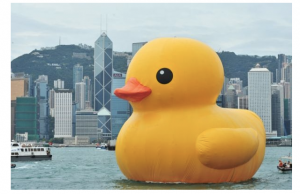
Florentijn Hofman, “Rubber Duck, Hong Kong” (2013), 14 x 15 x 16,5 meters, inflatable, pontoon and generator. (image via florentijnhofman.nl)
CHICAGO — A giant replica of the classic yellow rubber duckie drifted into Hong Kong’s harbor last month. Sailing across the water, bobbing about as if in a giant, public bathtub, the Pop art-inspired duck, created by Dutch artist Florentijn Hofman in 2007, is essentially an enlarged version of the “original” rubber duckie. Since 2007, versions of the duck have floated through the waters of harbors in Amsterdam, Belgium, Tokyo, Sao Paulo, and Sydney. In Hong Kong, the duck drowned due to deflation; shortly thereafter, it wasproperly copied and then set free to float again, appearing in harbors all over China including Xi’an, Dongguan, and Wuhan. The new versions were not made by Hofman and his team — they were Chinese shanzhai versions of the duck. The artist was furious, calling out the Chinese for stealing his idea, but really, the joke’s on the artist. He made a work of Pop art — a copy of the original rubber ducky. The Chinese shanzhai rip-off of Hofman’s duck are a curious commentary on the fact that Hofman’s work itself is a copy of an original, the only difference being that he held a copyright to it.
“Shanzhai does not thrive on creativity, it thrives on reaching those people who can’t reach the original product, either without geographic proximity or monetary power,” says Hong Kong-based arts and culture writer Jackie WX Tong. “Not everyone can come to Hong Kong to watch that dumb duck.”
Read the story on Hyperallergic: http://hyperallergic.com/75107/how-pop-art-got-ripped-off/



